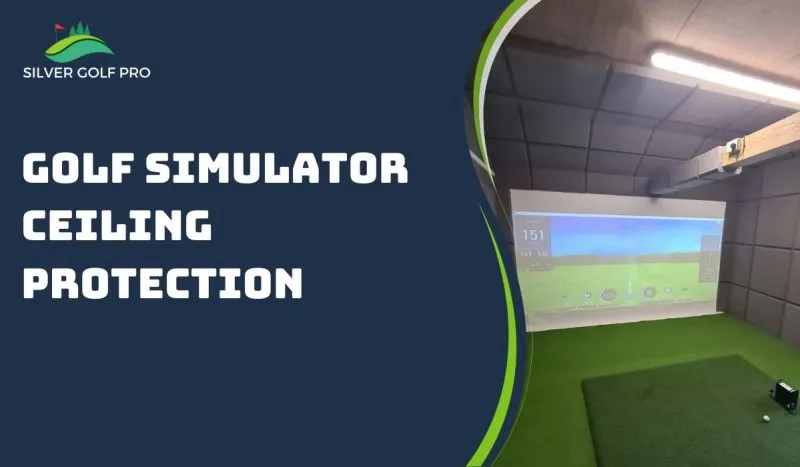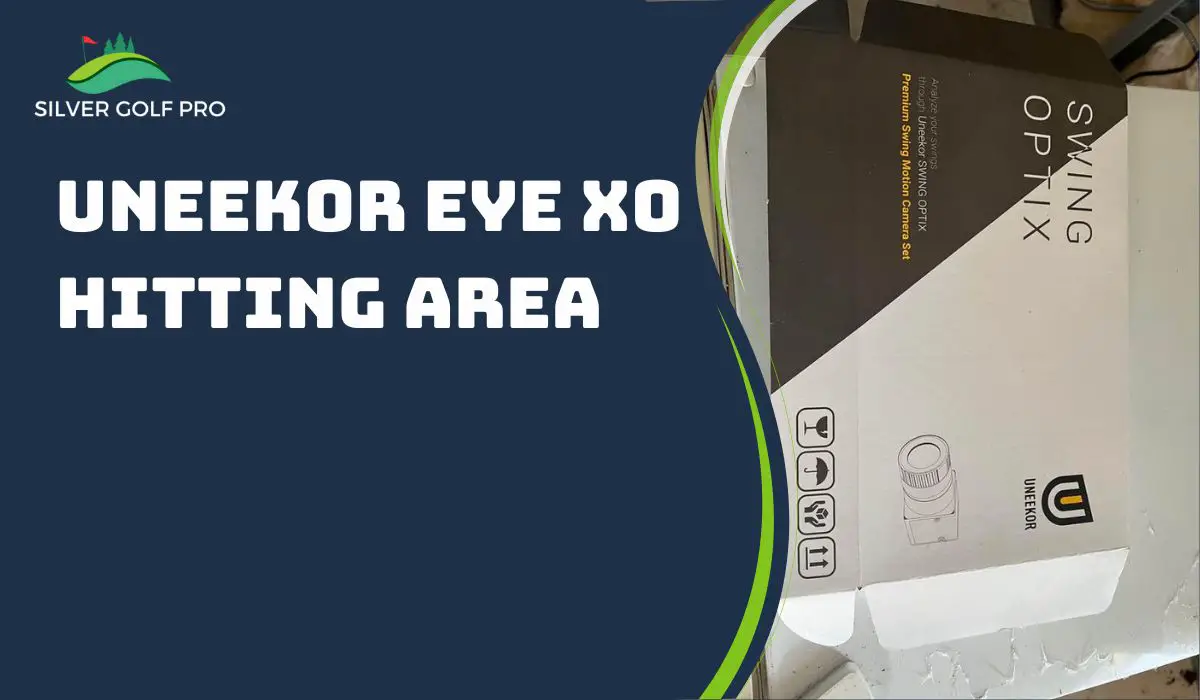The best golf simulator ceiling protectors are hanging nets, impact screens and interlocking foam mats. These solutions are all temporrary and can be removed after each use, keeping your ceilings in pristine conditions.
Through consulting manufacturers and patching numerous small holes at my own facility, I’ve learned to appreciate reliable protection that catches every ball. Such a system prevents expensive repairs and disruptions, helping facilities save money while safely hosting golf simulations indoors.
In this article, I will share lessons I’ve learned about selecting ceiling-friendly options to safeguard your space and allow simulated golf to continue without issues.
Skip To Section Here
- 1 Temporary Protection for Your Golf Simulation Ceiling
- 2 Permanent Protection for Your Golf Simulation Ceiling
- 3 Factors to Consider When Choosing a Protection Method
- 4 Common Mistakes to Avoid When Installing Golf Simulator Ceiling Protection
- 5 Safety Precautions for Installing Ceiling Protection
- 6 Tips for Ensuring a Secure and Effective Installation
- 7 Conclusion
Temporary Protection for Your Golf Simulation Ceiling
Facilities just starting out with golf simulations or those with limited space and budgets often look to temporary ceiling protection solutions. These options provide affordable, easy-to-install barriers against flying golf balls without extensive renovation costs.
Hanging Nets
Hanging nets are one of the most common solutions, as they provide an easy-to-install and affordable barrier. Nets designed for golf simulations are made of durable polypropylene or vinyl mesh that is resistant to tears from errant shots. They hang from the ceiling in a square or rectangular shape above the hitting area. While nets help contain balls, they require regular maintenance to remove accumulated balls and debris. Some find the bulky netting visually unappealing as well.
To install, follow these steps:
1) Measure the ceiling area and net/curtain dimensions.
2) Install overhead mounting tracks along the ceiling perimeter.
3) Mark the placement of mounting hardware on tracks at regular intervals.
4) Drill holes and secure hardware with screws or bolts.
5) Lift the net or curtain up and hook grommets or ties onto the hardware.
6) Tension as needed using turnbuckles or ropes
Batting cage-style enclosures
Batting cage-style enclosures, which fully surround the hitting area on all sides, including the ceiling. Companies like Cimarron Sports and Carl’s Place offer portable cages and screens that hook together with zippers or Velcro. These enclosures provide maximum ball containment without needing to be attached to any permanent structure. However, they can be time-consuming to set up and take down. The enclosed space may also feel claustrophobic for some golfers.
To install, follow these steps:
1) Assemble prefabricated panels, frames, and support poles.
2) Measure and mark the placement of poles within the room.
3) Drill holes in the floor or ground and secure poles with concrete or bases.
4) Attach panels and frames to poles, securing all connections.
5) Install zippered entry flaps as needed.
Impact Screens
Impact screens mounted to the ceiling are a less obtrusive alternative. Screens made of shatterproof polycarbonate or reinforced acrylic sheets securely fasten overhead. While quite durable, repeated impacts can eventually crack or break the material over time. Net Return is one supplier that manufactures heavy-duty screens specifically for golf simulations. Screens allow an open-air environment but lack the ball collection functionality of nets or full enclosures. They also require close inspection for damage after extensive use.
To install, follow these steps:
1) Measure the screen size and mounting hardware locations.
2) Mark and drill mounting holes in ceiling beams and joists.
3) Attach mounting brackets securely in place.
4) Lift the screen and secure the edges into mounting brackets.
5) Tension as needed using integrated turnbuckles or ropes
Interlocking Foam Mats
These mats are composed of cross-linked polyethylene (XLPE) foam tiles that are typically 2 inches thick. The tiles feature interlocking edges that allow them to be easily clicked together, creating a surface that can be walked on during installation.
The foam material is designed to cushion the force of incoming golf ball impacts. When a ball strikes the mat surface, the high-density foam compresses slightly to absorb much of the impact energy. This helps prevent balls from puncturing the ceiling material below. Tiles are rated to withstand hits from most woods, irons, and drivers when struck at reasonable speeds.
To install, follow these steps:
1) Measure the area and calculate the number of tiles needed based on size.
2) Start in a corner and lay the first tile with the edges facing out.
3) Place the next tile, clicking the edges firmly into the row below.
4) Continue laying tiles in rows across the area.
5) Cut tiles as needed around ducts or pipes using a utility knife or tile cutter, ensuring cut edges still interlock.
6) Once the main area is covered, ensure all tiles are fully interlocked by pulling edges and re-clicking any loose tiles.
7) Install perimeter tiles for a tight fit, cut as needed, inspect periodically, and re-click any loose tiles.
Permanent Protection for Your Golf Simulation Ceiling
For simulation facilities planning for long-term, high-volume use, permanent ceiling protection is typically the best choice. These more robust solutions are designed to withstand thousands, or even millions, of ball impacts with minimal maintenance or replacement required.
Reinforced Drywall
Reinforced drywall, plywood, or fiber cement board can be installed on ceilings. These materials are thicker and more durable than standard drywall and are better able to withstand direct impacts from golf balls without puncturing. Another advantage is that they can often be repaired and patched like regular drywall if damage does occur. A disadvantage is that reinforced materials may be more expensive than standard drywall.
To install, follow these steps:
1) Measure and cut drywall to size, allowing extra for trimming.
2) Attach drywall to ceiling joists using screws or nails spaced 8 inches apart.
3) Use drywall tape and joint compound to cover seams.
4) Sand smooth and paint or texture to match the existing ceiling.
Padding
Padding can also be installed on ceilings to absorb impacts. Various types of padding are available, such as gym mats, rubber padding sheets, or acoustic ceiling tiles that contain soundproofing material. Padding helps cushion the force from impacts, so ceilings are less likely to incur damage. It also helps control sound reflection. However, padding may need to be replaced more often as it can compress over time with repeated impacts. It also adds thickness to the ceiling space.
To install, follow these steps:
1) Roll out padding sheets and cut to size, allowing excess
2) Mark the placement of adhesive backing or fasteners.
3) Peel the backing and adhere sheets directly to joists or drywall.
4) Butt seams tightly and secure any overhanging edges.
Impact-resistant ceiling panels
Companies like Armstrong Ceilings and Acoustic Panels Art manufacture ceiling panels engineered specifically to withstand impacts from activities like golf simulations. These panels are made from strong, durable materials like fiberglass, mineral wool, or aluminum and come in various designs. They offer excellent protection from punctures or damage. A disadvantage is that they tend to be more expensive than standard ceiling tiles or drywall. Pro-Tee United also offers prefabricated impact panels and ceiling protection kits for golf simulators.
To install, follow these steps:
1) Measure the ceiling area and panel dimensions to plan the layout.
2) Mark the placement of mounting hardware locations on the ceiling.
3) Drill holes and secure mounting brackets.
4) Lift panels into place, securing them to brackets.
5) Seal edges with acoustical sealant.
Proper measurement, planning, and secure installation are key to ensuring protection methods support expected ball impacts without failure. Consult manufacturer guidelines for any specific ceiling types. Permits may also be required for some permanent solutions.
Factors to Consider When Choosing a Protection Method
Room Dimensions and Ceiling Height
The size and dimensions of the golf simulator room must be carefully considered when choosing a ceiling protection method. Smaller spaces under 10×10 feet have a higher risk of balls ricocheting forcefully, so reinforced materials, thick padding, or prefabricated panels are generally required for adequate safety, especially with lower ceilings under eight feet.
It is important to record the diagonal corner-to-corner length and precise ceiling height when measuring a room to determine the maximum usable area and clearance for protection.
Guidelines suggest minimum room sizes of 10×10 feet for single players up to 14×20 feet for multiple golfers, and manufacturers can then recommend solutions matched to the documented specifications and limitations of the simulator space.
When doing this, it’s also importanto to take note of all the other equipments like your simulator spotlights.
Budget Considerations
Budget is key when choosing a ceiling protection method.
Temporary options like rental nets or curtains costing $500–$1,000 monthly only last 1-2 years, while foam mat tiles costing $3–$5 each provide a lower-cost do-it-yourself installation.
Reinforced drywall costs $15–$30 per sheet plus hanging fees, while more robust impact panels range from $45–$75 for fiberglass to $150+ for aluminum.
Permanent systems have higher initial prices, with Pro-Tee United kits starting at $2,500 for a 16×16-foot system, but ultimately save money long-term by preventing costly repairs and downtime through lasting protection of the facility and its value.
Installation costs vary, with reinforced materials simply requiring a carpenter versus specialized labor to mount panels, and custom designs increase fees.
Aesthetic Impact
The appearance of a ceiling protection system can influence the overall look and feel of a golf simulator space. Temporary options like bounce-back curtains or nets allow customization of colors and patterns to match room themes, while interlocking foam tiles are basic but can be removed when not in use, altering the visuals to suit spaces with changeable designs.
Permanently installed solutions integrate more fully into a room’s style over the long run, with reinforced drywall or ceiling tiles blending seamlessly and prefabricated impact panels matching existing surfaces or providing a modern, industrial look.
Some manufacturers offer various panel styles and textures to complement traditional or contemporary interiors. Consider how solutions might clash with or complement different design schemes.
Common Mistakes to Avoid When Installing Golf Simulator Ceiling Protection
Here are some common mistakes and errors to avoid when installing golf simulator ceiling protection:
- Choosing the wrong size, material, or location for your ceiling protection
- Not following installation instructions or using improper tools or hardware.
- leaving an insufficient gap between the impact screen and ceiling protection.
- Failing to install a baffle or net to catch errant balls in the gap.
- Not testing your setup before use.
Safety Precautions for Installing Ceiling Protection
Installing ceiling protection systems requires taking proper safety measures to prevent injuries. A variety of tools and equipment are commonly used, each with their own hazards to be aware of. Following the precautions below will help prevent injuries from cuts, falls, inhalation of dust or fumes, electrocution, and overexertion during the ceiling protection installation process.
- Wear appropriate protective equipment like gloves, goggles or glasses, dust masks, ear protection, and closed-toe shoes based on the tasks.
- Inspect the work area for electrical wiring, pipes, ductwork, or other utilities that could be impacted and take precautions.
- Check walls and ceilings for integrity and weight load limits before adding materials.
- Ensure ladders are in good condition, have slip-resistant feet, and are set up on stable, level surfaces. Do not overreach when working at heights.
- Use caution when sawing, drilling, hammering, or lifting heavy materials to avoid cuts, impacts, or strains.
- Secure any loose materials that could fall if bumped during the work.
- Maintain good ventilation if using products with fumes, and do not work in confined spaces with hazardous vapors.
- Take breaks as needed to avoid injury from fatigue, and have assistance for heavy lifts or high work.
- Follow all safety data sheets and manufacturer instructions for the safe handling of tools and materials.
- Watch out for overhead hazards and look out for others in the workspace.
Tips for Ensuring a Secure and Effective Installation
Testing Strength and Stability
- Gently toss a tennis ball or similar soft object up at the protection from various angles to check for any movement or gaps.
- Use a golf club, broom handle, or other long object to carefully poke at different areas from the ground to test stability.
- Consider having a helper stand on a ladder or lift while another person tests from below to fully cover all areas.
Making Adjustments
- Loosen bolts or screws very slightly if the protection moves more than a couple inches with force.
- Tighten the fixings a small amount if the protection allows visible gaps when pressure is applied.
- Lower the protection if it is too high for its intended purpose or safety standards.
- Raise the protection if it is too low and does not provide full coverage.
Conclusion
This article covered the key considerations for selecting and installing ceiling protection for a home golf simulator.
Whether used for practice, games with friends, or off-season enjoyment, golf simulators allow players to swing indoors while protecting their homes. With the right ceiling shield in place, simulators can provide hours of virtual golf entertainment.









